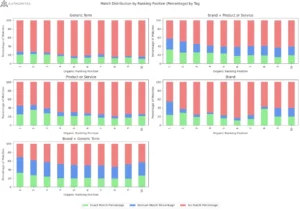In this Digital Roundup we cover a number of topics where there has been some interesting developments over the last few weeks. As always we have been talking a lot and have come across some interesting news and cool ideas that we have pondered over, utilized and thanked the bloggers for their efforts.
The first post that I would like to point out is the API Extension for Excel for Mozscape by SEO Gadget.
If you missed it then you’ve got to see it. If you’re not using it, get on it!
Announcing: The Links API Extension for Excel for Mozscape
This post, written by Richard Baxter explains the new API that was released a couple of weeks ago. With this extension you can build reports and assemble quick applications to obtain valuable link data from all 4 Mozscape API flavours.
The post shows how this API opens up new possibilities and shows some insight into how applications and reports like this are now possible.
You can download the Mozscape API here
The great thing about having the API with the Excel sheet created by SEO Gadget is that you can now save all your data in Excel and play with it as you will. The sheet updates automatically, filters for nofollow, external and internal links and in fact has almost all the features of Open Site Explorer.
This extension is a platform upon which you can build reports, tools and perhaps most importantly, combine Mozscape data with data collected via SEO Tools for Excel and include your own hacks and keyword search volume.
There is no more waiting time for downloads, everything can be done from within Excel. Here’s the short video tour highlighting the capabilities of the new extension:
SEOmoz Pro Members Can:
- Extract large volumes of link data from the Mozscape API
- Fetch anchor text links to your domain
- Identify the top pages on your domain (with paid API)
- Capture URL metrics data for groups of URLs
- Plays nicely with the SEOmoz API
- Plays nicely with the Adwords API extension and SEO Tools for Excel
You can see more about the different queries on the original post. To install the API follow these instructions:
- Firstly, download the file:
- Save the distribution folder on your desktop and open the setup.xlsx file. When it opens, click “Enable Content”:
Click “Install Add in” – when the process has successfully completed, you’ll get confirmation.
Generate Great Ideas by Connecting with Customers
Kate Morris writes that great ideas can come with the aid of customers. She goes on to say that you must stop thinking like an executive, SEO or competitors and start thinking like a customer would. Getting out of your own head is the key to generating fresh ideas. Kate then gives a detailed account of how to go about getting the best ideas.
Firstly, get out of the office. For consumer facing industries, go and find customers. If you can visit a retail location, do that. If you are an online retailer, look up some clients and ask if you can visit them. Find a few “real people” and ask for 15 minutes to chat with each of them.
If you are not a retailer but more business to business oriented do as the online retailer does and look up clients and set up a meeting to visit a few of them. If customers are hard to reach because they are not in the same country then a Skype call works just the same.
You need to enter their world. Don’t plan questions, don’t take more time than they give you. Just have a chat, be brief and ask them about their day. Really get to know them and take notes.
Then, don’t go back to the office. Find somewhere that isn’t home or work where you can be creative and productive for a few hours. Think like your customers. How would they say your marketing plan should be. What is the company’s USP? You want to make your business the favorite place for customers to go online and offline when they need something related to your business. How do you make your company that important?
Write down all your ideas! Then answer all the questions, whether they are plausible or not, answer them. The only concern is making the customer happy. Do not think about any other factor, whether that be money, getting links, shares. Just make them love you.
After questions have been answered these notes can turn into ideas and successes for all your other usual processes including link building.
I don’t do the original post justice so you can go read it here.
8 Rules of A/B Testing – The Art in Marketing Science
Uri Bar-Joseph of Optify gives 8 rules of A/B testing.
- Hypothesis
As always, start with a hypothesis. This is a short sentence that summarizes what you are trying to prove/refute and should include the tested variable and success metric. - One Variable
In A/B testing we are only testing one variable. So keep everything else constant. - Clear and Aligned Success Metric
Before you begin running the test, decide how you are going to be measuring success. Do not make the common mistake with A/B testing where you look at multiple success metrics and decide which one is most important after the test. - Volume and Statistical Significance
For a successful test you must have enough volume to make the data statistically significant. - Test Group and Splits
Volume should be applied to the test group, not only the overall size. - Randomization
Your control and test groups should be picked randomly. - Always be Testing but Apply Common Sense
While everything is testable, not everything should be tested. Always use common sense. - Documentation
This is one of the most neglected elements in testing in which software can help.
You can also read about a great case study where a client became the fifth-fastest-growing company in the UK that was done using A/B testing here. The main takeaways from this case study are:
- Find out (not guess) why some people walk away. Addressing the objections of potential customers is incredibly important.
- Find out what other people like. Really listen to what your existing customers are saying. One of the best ways to articulate your benefits is to use the words that they use.
- Repeat changes throughout your website. If a change is effective, look for where else in the business it can be implemented.
- And again, prioritize those low-hanging fruit. Make the simple changes that have a high chance of increasing your conversion rate.
Upgrades To Google Analytics Content Experiments
To continue with A/B testing Daniel Waisberg of Conversion Journey writes about upgrades to Google Analytics content experiments.
It is now possible to copy experiments which allows marketers to perform additional tests to the same page without modifying the codes, which makes the process much shorter and easier to implement. In order to copy an experiment, go to your experiments results page and click on “view settings”. Then on the settings page, on the bottom right corner you will find the “copy experiment” button. After clicking the button, you will get the following message:
“Copying an experiment will copy the current settings into a new experiment—where you can adjust as you desire. It will not affect the current experiment. There is no need to reinstall the experiment code on your test page in order to run the copy.”
Support for relative URLs for variation pages has been upgraded. This upgrade is extremely important as it allows website owners to test different page variations without having to create multiple URLs, they can simply create a version that has a different URL parameter.
Improvement to the experiments report. Google added standard report capabilities to the experiment reports, such as: Site usage, goal sets, ecommerce and adsense. This means that from now on users will be able to compare the page variations based on all the metrics, not only the goals defined while setting the experiment.
Some other posts that we enjoyed or found interesting were:
Internal Linking Strategies for 2012 and Beyond
John Doherty of Distilled did a whiteboard friday called “Smarter Internal Linking” which he recommends watching before reading this post. Either way, it is a good read with some valuable information.
I did my first Whiteboard Friday this week. Smarter Internal Linking – http://t.co/2bii1pcc
— John Doherty ? (@dohertyjf) July 27, 2012
How Website Structure & Information Architecture Should Mirror Your Business Goals
Trond Lyngbø of Metronet Norge writes a detailed article which looks at information architecture and website structure. This helps you understand the essence of having a website with a strong core that is well built from the basic fundamentals to what shapes and strengthens it.
New notifications about inbound links
The Google Webmasters Central Blog rolled out new notifications about inbound links. There are now two types of links.
- The original link message has been around for months now which means if the link metrics are severely distrustful then the trust may be reduced on the entire site.
- The new link message sometimes targets specific or artificial links so only the page that these links are pointing to are affected.
The post goes into a lot more detail and gives examples of different types of links and also offers advice on what to do if the new link message is received. The advice basically states that you should be aware check the links and see if anything “fishy” is going on.
Is the rel=”author” tag becoming more integrated into organic SERPs?
And last but not least, Alex Moss’s post which investigates Google’s SERPS into whether or not Google is starting including the rel=”author” rich snippet into the local results.
From what Alex saw, he only found one result that displayed this rich snippet in the local result:
This result is showing in both .com and .co.uk with ‘pws=0’ inserted. There was however one difference in the .com from the .co.uk where there is a link directing you to more by [name]:
Clicking on this link took Alex to an author related SERP:
This page only appears in Google.com. The exact same query in .co.uk returns the following result:
If you notice at the top of the .com result there is a small line of text with a link to Google Authorship where you can follow easy steps to implements rel=”author”.
Alex concludes that Google seem to be increasing author integration into the SERPS and this tells us that Google+ profiles are becoming more important and relevant for exposure.
I hope you have enjoyed this installment of the Digital Roundup. Comments as always, are welcome as always 🙂







